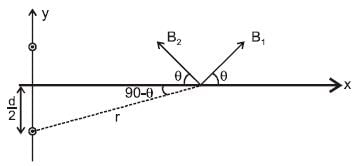NEET Part Test - 4 - NEET MCQ
30 Questions MCQ Test NEET Mock Test Series 2025 - NEET Part Test - 4
A and C are concentric conducting spherical shells of radius a and c respectively. A is surrounded by a concentric dielectric medium of inner radius a, outer radius b and dielectric constant K as shown in the figure. If sphere A is given a charge Q, the potential at the outer surface of the dielectric is.


In the given circuit the rms value of voltage across the capacitor C, inductor L and resister R1 are 12V, 10V and 5V respectively. Then the peak voltage across R2 is


Two identical capacitors C1 and C2 are connected in series with a battery. They are fully charged. Now a dielectric slab is inserted between the plates of C2. The potential difference across C1 will :


A solenoid having an iron core has its terminals connected across an ideal DC source. If the iron core is removed, the current flowing through the solenoid

An electric field ‘E’ whose direction is radially outward varies as distance from origin ‘r’ as shown in the graph. E is taken as positive if its direction is away from the origin. Then the work done by electric field on a 2 C charge if it is taken from (1, 1, 0) to (3, 0, 0) is

A negative test charge is moving near a long straight current carrying wire. A force will act on the test charge in a direction parallel to the direction of the current, if the motion of the charge is in a direction:
Potential difference between centre and the surface of sphere of radius R and having uniform volume charge density ρ within it will be :
The magnetic field at the origin due to the current flowing in the wire is
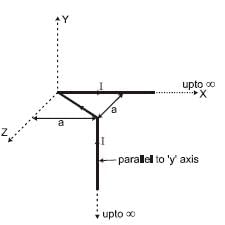
There exists a uniform electric field in the space as shown. Four points A, B, C and D are marked which are equidistant from the origin. If VA, VB, VC and VD are their potentials respectively, then
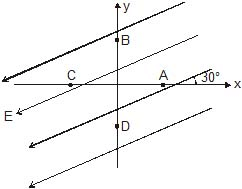
A current carrying wire AB of the length L is turned along a circle, as shown in figure. The magnetic field at the centre O.

Total electric force on an electric dipole placed in an electric field of a point charge is:
The magnitude of magnetic field at O (centre of the circular part) due to the current carrying coil as shown is :
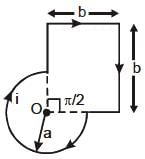
Eight point charges (can be assumed as small spheres uniformly charged and their centres at the corner of the cube) having values q each are fixed at vertices of a cube. The electric flux through square surface ABCD of the cube is
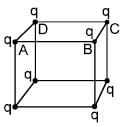
A charged particle is moving in the region around a long current carrying wire. Due to wire, it may experience:
The figure shows a charge q placed inside a cavity in an uncharged conductor.
Now if an external electric field is switched on :
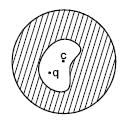
Two infinite sheets carrying current in same direction (of equal current per unit length K) are separated by a distance ‘d’. A proton is released from a point between the plates with a velocity parallel to the sheets but perpendicular to the direction of current in the sheets. Then the path of the proton is

Three large parallel charged conducting plates are placed at a small distance d apart from each other. The surface charge density on the face B of the conductor is +5.0 εo coulomb/m2 and that on face E is + 6.0 εo columb/m2. Charges on other faces are not known. The electric field intensity at P (shown in the figure) between the plates is
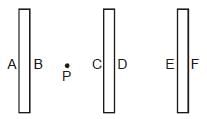
A horizontal metallic rod of mass 'm' and length ' l ' is supported by two vertical identical springs of spring constant 'K' each and natural length l0. A current ' i ' is flowing in the rod in the direction shown. If the rod is in equilibrium then the length of each spring in this state is:
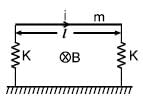
A 150 m long metal wire connects points A and B. The electric potential at point B is 50 V less than that at point A. If the conductivity of the metal is 60 × 106 mho/m, then magnitude of the current density in the wire is equal to :
A battery of internal resistance ' r ' and e.m.f. ε is connected to a variable external resistor AB. If the sliding contact is moved from A to B, then terminal potential difference of battery will :
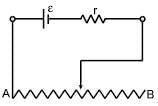
In the figure shown the equivalent capacitance between 'A' and 'B' is :
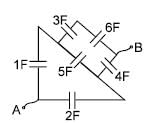
A very small circular loop of area 5 × 10–4 m2 and resistance 2 ohm is initially concentric and coplanar with a stationary loop of radius 0.1 m. If one ampere constant current is passed through the bigger loop and the smaller loop is rotated about its diameter with constant angular velocity ω. The current induced (in ampere) in the smaller loop will be :
The capacitor shown in figure 1 is charged completely by connecting switch S to contact a. If switch S is thrown to contact b at time t = 0, which of the curves in figure 2 above represents the magnitude of the current through the resistor R as function of time t ?
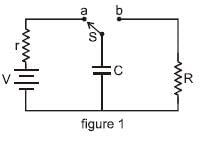

At a given instant the current and self induced emf in an inductor are directed as shown in figure. If the induced emf is 17 volt and rate of change of current is 25 kA/s the correct statement is :

In the figure shown a parallel plate capacitor has a dielectric of width d/2 and dielectric constant K = 2. The other dimensions of the dielectric are same as that of the plates. The plates P1 and P2 of the capacitor have area 'A' each. The energy of the capacitor is :
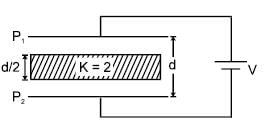
A rod of length l having uniformly distributed charge Q is rotated about one end with constant frequency ' f '. Its magnetic moment.
Two identical spheres of same mass and specific gravity (which is the ratio of density of a substance and density of water) 2.4 have different charges of Q and – 3Q. They are suspended from two strings of same length l fixed to points at the same horizontal level, but distant l from each other. When the entire set up is transferred inside a liquid of specific gravity 0.8, it is observed that the inclination of each string in equilibrium remains unchanged. Then the dielectric constant of the liquid is
Two infinitely long parallel wires are a distance d apart and carry equal parallel currents I in the same direction as shown in the figure. If the wires are located on y axis (normal to x-y plane) at y = d/2 and y =  then the magnitude of x-coordinate of the point on x-axis where the magnitude of magnetic field is maximum is (Consider points on x-axis only)
then the magnitude of x-coordinate of the point on x-axis where the magnitude of magnetic field is maximum is (Consider points on x-axis only)
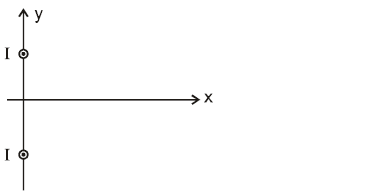
|
1 videos|26 docs|111 tests
|













 shall act on the negatively charged test particle in direction parallel to current carrying wire, if the velocity
shall act on the negatively charged test particle in direction parallel to current carrying wire, if the velocity  of the negative charge is as shown.
of the negative charge is as shown. 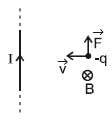




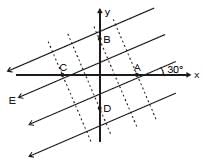




 (sin 45° + sin 0°) =
(sin 45° + sin 0°) = 




 very small.
very small.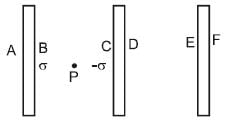





 (or as J = σ E)
(or as J = σ E)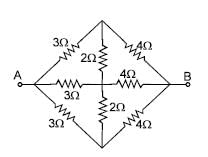
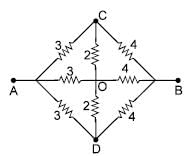
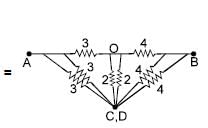

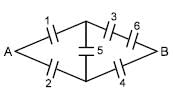
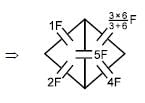
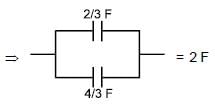











 equivalent current di = f dq
equivalent current di = f dq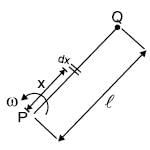
 ⇒
⇒ 

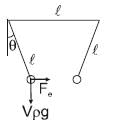
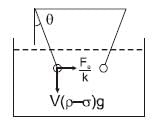


 are magnetic field at P due to wire 1 and 2.
are magnetic field at P due to wire 1 and 2.
